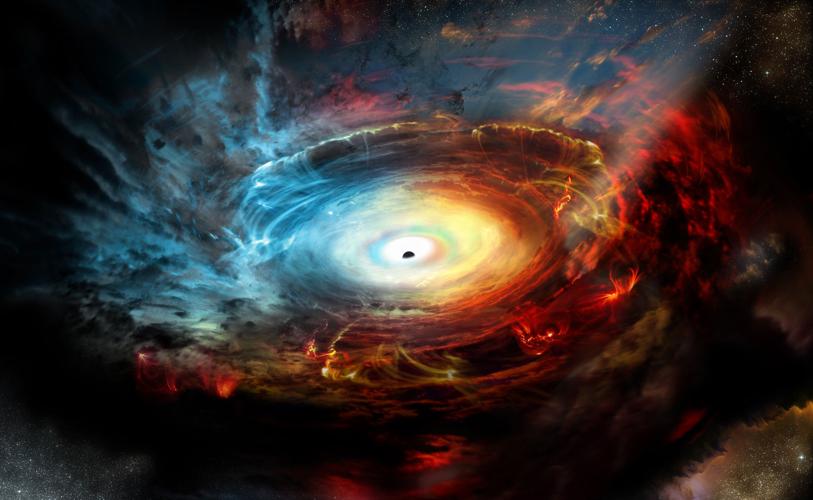Astronomers pointed a global array of radio telescopes at the center of our galaxy this week, hoping to image a glowing, swirling rim at the edge of a black hole that has swallowed the equivalent of 4 million suns.
The work of the Event Horizon Telescope team could once again prove Einstein right, or finally prove him wrong if relativity doesn’t work as predicted in the vicinity of such an intense gravitational force.
They won’t find out right away.
It will take some fancy computing and up to a year to combine the vast amount of data from the global array that forms a virtual telescope as big as the Earth itself.
Data from the southernmost telescope can’t even be retrieved until spring allows flights to the South Pole in late October, said astronomer Dan Marrone of Steward Observatory.
Marrone installed the receivers for the experiment last year during the polar summer.
He said the weather this week has been cooperative — the “best global weather” he’s seen in 20 years of linking radio telescopes.
Southern Arizona, which was buffeted by high winds and partially obscured by thin clouds during some of the observing runs, was “acceptable” even during those times, said Lucy Ziurys, director of the Arizona Radio Observatory, with telescopes on Kitt Peak and Mount Graham.
The Mount Graham Submillimeter Telescope Observatory participated in the observations. Marrone went to Mount Graham to set that up, then supervised it and the South Pole Telescope by phone.
The global weather was so good that astronomers wrapped up their five nights of observations a full four days ahead of schedule, completing the gathering of data on Tuesday morning. “Five successful nights and, yes, we could have gone a few more days if needed … but the weather was kind to us,” Marrone said in an email Tuesday.
Now the hard drives from the campaign will be flown to MIT’s Haystack Observatory and to the Max Planck Institute for Radio Astronomy in Bonn, Germany, where the millions of gigabytes of data will be combined and then analyzed to produce a picture of what happens at the “event horizon” of a black hole.
A black hole is a phenomenon so dense that nothing can escape from it, including light. Astronomers only know of their existence because of the gravitational effects they have on nearby objects.
But while you can’t see a black hole, the theory of general relativity predicts that the rim of a black hole — its event horizon — will glow with the light of the intense radiation caused by matter being compressed into near-nothingness. Optical telescopes can’t see through the massive clouds of dust and gas. The longer wavelengths of radio telescopes should reveal it.
The data that will produce a picture of the event horizon at the center of the Milky Way, known as Sagittarius A Star (Sgr A*), will take six months to a year to process, said Marrone.
The data is carefully date-stamped, using atomic clocks installed at the observatory sites.
Precise overlay of the data is crucial to the process known as very-long-baseline interferometry, which creates a virtual telescope with the resolving power of one the size of the entire globe, by combining observations from North and South America, Europe, Hawaii and the South Pole.
The Event Horizon team, led by Sheperd Doeleman of the Harvard-Smithsonian Center for Astrophysics, has conducted previous observations with fewer telescopes.
The addition of the South Pole Telescope doubled the virtual telescope’s resolving power, said Marrone.
Adding ALMA — the Atacama Large Millimeter/submillimeter Array in Chile — increased the virtual telescope’s overall sensitivity by a factor of 10, according to the European Southern Observatory’s webpage.
That resolution and sensitivity are needed to image a phenomenon that is 26,000 light years away and described as a “pinprick” on the night sky, despite its massive size. Astronomers compare it to trying to see a grapefruit on the moon.
“This week heralds an exciting and challenging endeavor for astronomy,” said France Córdova, director of the National Science Foundation in a news release. The NSF provided funding for the project and partially funded construction of ALMA.
Theoretical astrophysicists Feryal Ozel and Dimitrios Psaltis of the UA’s Astronomy Department, were at MIT to help coordinate the experiment. They also led a computer simulation at the UA that predicted the size and shape of the event horizon and the “shadow” of the black hole, based on Einstein’s math.
If the image produced from this week’s campaign differs significantly from that prediction, scientists will have to rethink things.
“In my wildest dreams, I hope for seeing a deviation from the predictions of general relativity,” Ozel told the Arizona Daily Star in January.
“If what general relativity predicts breaks down at some level, then it’s going to be path-breaking.”





